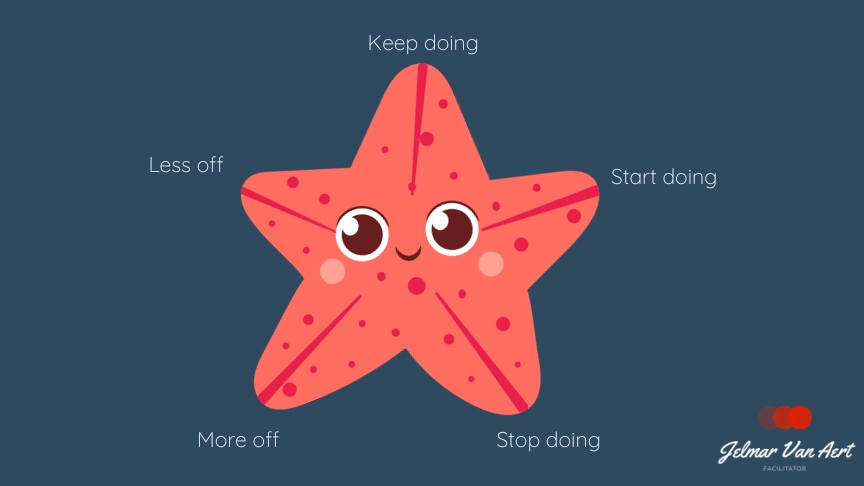Unlock the Power of Starfish Retrospective for Project Success
Unlock the Power of Starfish Retrospective for Project Success
Introduction
If your team’s retrospectives feel uninspiring, why not explore a technique that can help you amplify performance and collaboration? I suggest the Starfish Retrospective approach. This method has five components that enable teams to analyze their accomplishments and pinpoint potential areas of improvement for generating value. In this blog post, we provide details about how to use the Starfish Retrospective efficiently. My advice will take away any anxieties about executing this retrospective skillfully – follow these tips and observe what heights your team can reach in no time!
Key Takeaways
- Unlock the power of Starfish Retrospective for project success
- Get insights into five components of the model and the benefits it offers
- Learn tips on how to prepare, prioritize ideas & assign responsibilities
Understanding the Starfish Retrospective Technique
The Starfish Retro is an efficient system that empowers agile teams through evaluations, area improvements, and value creation. This technique works well for agile groups as it provides them with a structured yet versatile way of executing retrospectives to recognize actionable items so they can better their current practices and activities. By taking advantage of the starfish retrospective template, squads can streamline the whole process and ensure that each facet connected with this type of reflection has been adequately tackled.
By applying the Starfish procedure along with performing said starfish exercise, your team will be able to raise its performance standard while working collaboratively at achieving even more success on projects thanks to leveraging off what a starfish template offers you all.
The Five Components of the Starfish Model

The Starfish Retrospective centers around the five-category Starfish Model, which can help teams examine their processes and consider changes that could maximize value. As an example of how this model works in practice, ‘Keep Doing’ encourages recognizing what works well and continuing with those activities. While ‘Start Doing’ promotes brainstorming fresh ideas for potential improvement.
In agile projects especially, the flexibility afforded by these categories makes it an ideal tool for sprint retrospectives as they encourage open discussion amongst team members – all team members will have a voice throughout the retrospective. The benefits derived from addressing each category allow teams to gain unique insights into existing practices while spotlighting areas where performance or Enhancement may be possible.
The first three categories are closely related to the start, stop, continue retrospective.
Keep doing
What should the team keep doing? What do they like about the current practices that are helping them move forward?
Start doing
What should the team start doing? What are they not doing yet that can help them improve their current practices?
This is the brainstorming component of the starfish retrospective template. Each team member can add their ideas.
Stop doing
What should the team stop doing? What is hurting them now?
In this section, the agile team takes a look at their current practices and sees what they can stop so that they can deliver more value.
More of
What is the team doing now that works well, and they should do more? Are they not aligning enough around the work?
Less of
What is the team doing now that is hurting them that they should do less of? Are there too many meetings? Are they regularly going into circular discussions?
Benefits of Using the Starfish Technique
The Starfish Technique is highly valuable for its flexibility and comprehensiveness, bringing many rewards to project management, workflow improvement, and team engagement. This technique centers on pinpointing core issues to cooperate effectively toward solutions.
In general, running retrospective meetings regularly helps improve team cohesion and alignment.
How to run a Successful Starfish Retrospective Meeting

For a successful Starfish Retrospective, proper preparation is required. This involves creating an inviting atmosphere for conversation and idea sharing, forming rules of engagement that everyone understands, and respecting timeboxes.
While selecting the appropriate retrospective tool, consider participating members – especially those in different countries - as they might not be available at regular hours to join your team’s discussions or brainstorming sessions.
To ensure every rehearsal is productive with efficient results towards improvement, use the best practices provided below!
Setting the Stage
Prior to commencing the Starfish Retrospective, it is essential for a comfortable setting that promotes transparent and open conversation. This consists of introducing the agenda for the gathering, clarifying how exactly this specific retrospective will run using its steps, and outlining what all team members should contribute to achieving success during discussions.
Establishing an environment where everyone feels safe and confident enough to voice out their opinions accompanied with bright ideas without facing any judgment or criticism; allowing various aspects from different perspectives, which becomes quite helpful when brainstorming for solutions.
Establishing Guidelines
To ensure a successful Starfish Retrospective, specific guidelines and expectations must be outlined during the meeting. This includes defining why the retrospective is taking place, introducing how one should use the Starfish technique, and establishing rules on discussion and participation among all team members.
Creating an environment of collaboration with a clear structure can help your team effectively get through their process while making notable progress in their goals.
Time Management and Timeboxing
Time management and timeboxing are important for maintaining the focus of your Starfish Retrospective. Establishing a timeline for each element in the agenda allows all topics to be covered within an appropriate amount of time, thereby avoiding spending too much energy on any one area.
This technique assists with prioritizing conversations during the retrospective process. Guaranteeing that every step is given enough attention which will eventually lead to a more successful and insightful meeting experience.
Example of the agenda
One way to run the retrospective is to timebox each section of the starfish retrospective.
| Exercise | Time |
|---|---|
| Setting the stage | 5 min |
| More of | 3 min |
| Less of | 3 min |
| Keep doing | 3 min |
| Stop doing | 5 min |
| Start doing | 5 min |
| Vote and discuss | 30 min |
Another way to run the retrospective is to give the team the freedom to fill in the different parts of the starfish retrospective.
| Exercise | Time |
|---|---|
| Setting the stage | 5 min |
| Fill in the parts of the starfish | 20 min |
| Vote and discuss | 30 min |
Implementing Changes and Ideas from the Starfish Retrospective

Once your Starfish Retrospective has come to an end, it’s time to move on and start implementing the suggestions that were made at the meeting. This involves deciding which ideas are more important than others, assigning tasks according to individual expertise, and keeping track of progress with a view toward ongoing development for project success.
Putting into practice all the insights gained during your retrospective is crucial if you want to maximize team potential in order to reach meaningful changes. To help implement these modifications outlined by Starfish Retrospectives, we will discuss strategies applicable when prioritizing initiatives, distributing responsibilities correctly, and overseeing progression accordingly.
Prioritizing Ideas with Dot Voting
Using dot voting is a straightforward and helpful approach to help the team recognize which modifications are of the highest importance. By having all crew members take part in determining through this system, it can lead them feeling empowered as they will have had an influence on how the plan moves ahead. The dots placed next to ideas allow for quickly finding out what needs attention first so that energy goes into implementing those changes that will be most effective.
Assigning Responsibilities and Monitoring Progress
After taking into account the priorities determined via dot voting, it is vital for a team to designate duties and supervise advancement in order to ensure that each task can be completed properly. Each team member's role should be outlined along with respective deadlines as well as check-ins or notifications tracking the progress of said tasks.
If you are using daily standups with your team, this can be the perfect place to check in on the tasks.
It’s important that everyone is held responsible and routinely monitored so improvement persists steadily within the entire group towards fulfilling their goal effectively.
Adapting and Evolving Based on Feedback
As your team implements changes and ideas from the Starfish Retrospective, it’s essential to listen carefully to feedback and modify approaches when necessary. This may include modifying processes, redefining objectives, or altering tasks due to new data points or shifting agendas.
By maintaining an outlook of continuous growth and knowledge acquisition, your agile teams can grow as a unit, delivering superior results while propelling project success ahead.
Summary
The Starfish Retrospective emerges as a powerful tool for teams seeking to enhance their processes and boost overall effectiveness. By utilizing the flexible Starfish Model, teams can systematically evaluate what is working well and identify areas for improvement. The structured approach of 'Keep Doing,' 'Start Doing,' and other categories facilitates open discussions, ensuring every team member's voice is heard.
Frequently Asked Questions
What is the small starfish retrospective?
The Small Starfish retrospective is an altered version of the starfish activity, which involves a canvas divided into 3 parts. It serves to provide teams with valuable knowledge about their practices and how they can improve them.
The three sections on this canvas are Keep doing, Less or Stop, and More off. Each section helps each team member reflect on what they can improve.
What are the 5 questions of a starfish retrospective?
At a starfish retrospective, one can ask four questions to gain useful feedback: “What should we stop doing?”, “What could we do less of?”, "What should we do more of?", "What should we start doing?", "What should we keep doing?".
Can remote teams effectively use the Starfish Retrospective?
Remote teams can make use of the Starfish Retrospective effectively by picking a suitable tool, like Miro, motivating active participation and accounting for differing time zones.
How can my team prioritize ideas from the Starfish Retrospective?
The team should prioritize their most essential ideas by having each member mark which they think are the best options, thus aiding in quickly finding and prioritizing those modifications. You can take a look at the full blog post focused around voting and prioritization in retrospectives.

